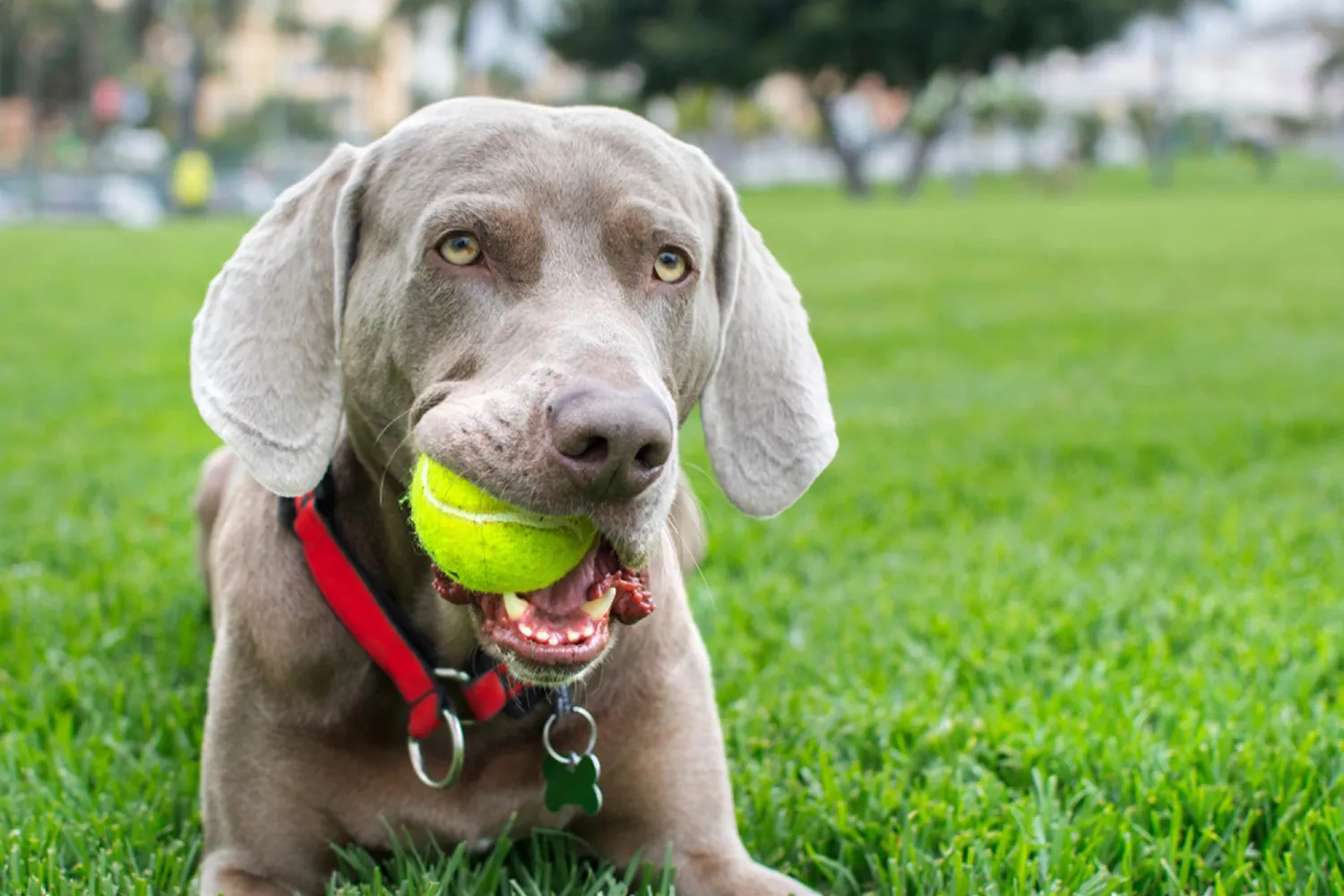
The Weimaraner is one of those dogs you spot from across the park and think, wow. That sleek, silver grey coat almost shimmers in the sun, and those big floppy ears have a personality all their own. I remember meeting a friend’s Weim named Luna she trotted past like a runway model, ears bouncing, eyes locked on a tennis ball as if it were her life’s mission. People sometimes call them “gray ghosts,” and once you see that gliding gait, you’ll get why.
Originating in Germany as a large sporting dog, the Weimaraner was bred for long, busy days in the field. That heritage shows up in their energy and focus, so plan on plenty of exercise and brain work. Mine has always done best with a mix of long walks, a good game of fetch, and “sniffaris” where I let them follow their nose along new paths. They’re smart sometimes a little too smart so puzzle toys and short training sessions keep them happy and out of mischief. A tip I learned the hard way: teach a solid recall early and practice it often, especially around exciting distractions. After all that action, they’re total cuddle bugs at home, flopping those silky ears onto your lap like they were made for it.
History and Origin of the Weimaraner
Whenever I see a Weimaraner’s sleek, athletic silhouette, I think about how “new” their story is compared to many old world hunting breeds. While some gun dogs trace their roots back centuries, the Weimaraner really came into its own in 19th century Germany. Breeders there set out to create the ultimate all around sporting dog, blending French and German hunting lines to get a powerful, eager partner with endurance to spare.
In those early days, these dogs weren’t just flushing birds. An adult Weimaraner was used to track and help take down serious big game think wolves and even bears. It’s a little wild to picture, especially if your Weimaraner currently prefers the sofa and a squeaky duck toy. But that grit and drive are still in there. A friend of mine once joked that her Weim can spot a squirrel three blocks away and consider it “mission critical.”
As hunting needs shifted, so did the breed’s role. Weimaraners became stars in the fields and wetlands as gun dogs, prized for their ability to point and retrieve fowl and other game birds. I remember watching one freeze in a perfect point on a windy autumn morning tail straight, eyes locked like a living statue. If you bring one home today, that focus is a gift you can channel into nose work, retrieving games, and long, purposeful walks.
By 1897, the breed had been formally recognized in Germany, and the German Weimaraner Club formed to protect and shape it. Breeding was limited to members of this national club, which kept the gene pool carefully managed and the breed’s traits consistent. That kind of gatekeeping may sound strict, but it’s part of why Weimaraners developed such a distinct look and working style.
The Weimaraner made the leap to the United States in 1938 and wasted no time earning fans. The American Kennel Club officially recognized the breed in 1943, and enthusiasm grew enough to inspire the Weimaraner Club of America. Today, they regularly sit among the AKC’s 40 most popular breeds no surprise to anyone who’s fallen for their combination of brains, athleticism, and loyalty. I once chatted with a longtime owner at a training field who said, “They’ll give you everything, as long as you give them a job.” That’s a good rule of thumb: with their sporting heritage, Weimaraners thrive on daily exercise, clear training, and plenty of chances to use that marvelous nose. Give them purpose, and they’ll give you their heart.

What Is the Weimaraner Breed?
Meet the Weimaraner: a large, athletic sporting dog built for action and adventure. They were bred for endurance, and you can see it in every sleek line of their strong bodies. That handsome head has a hound like look, with big, velvety ears that flop just right and a steady, alert expression that says, “What’s next?” I remember the first time I met one on a trail run by the third mile, I was huffing and he was still trotting along like it was a warm up lap.
Their coat is one of their signatures: short, silky, and shimmering anywhere from silver gray to a more muted gray, which is why folks call them the “Gray Ghost.” In certain light they almost glow especially at dusk. The best part for busy owners is how low maintenance that coat is. A quick brush to keep the shine and a wipe down after muddy adventures usually does the trick. I keep a soft grooming mitt by the door and give a fast once over after walks. Those big ears, though, appreciate a gentle check and wipe now and then.
Weimaraners are famously clever charmingly so, until they figure out how to open your cabinets. These dogs don’t just learn commands; they learn systems. I’ve watched a friend’s Weimaraner nudge a door handle, hop up to peek at the counter, then pivot to the sink like he had a to do list. Baby locks and sturdy latches became household decor. Channel that brainpower with puzzle toys, scent games, and training sessions that actually make them think.
Because they were designed to go, they need real, vigorous exercise. Long runs, fast hikes, or a solid fetch session can make all the difference. When their bodies and minds are satisfied, Weimaraners melt into family life sweet, loyal, and wonderfully entertaining. If you love an active routine and don’t mind a dog who occasionally outsmarts you, the Gray Ghost makes a dazzling, devoted companion.

Who Is a Weimaraner Best For?
If you’re dreaming of a big, athletic shadow who’s always up for the next adventure, a Weimaraner might be your perfect match. These dogs thrive with people who love being active think daily runs, long hikes, bike rides, or dog sports. A friend of mine competes in canicross with her Weim, and that dog lights up the second the harness comes out. Agility, tracking, nose work, dock diving you name it, they’ll give it their all.
Weims need plenty of physical exercise and mental work to keep them from getting into mischief. When mine was young, two good workouts a day plus training games kept the shoe chewing to a minimum. Mix it up: fetch in a safe field, “find it” scent games around the house, puzzle feeders on rainy days, short obedience sessions between errands. A tired Weim is a happy Weim and a delightful housemate.
They’re true pack animals and famously “velcro” with their people. If you’re gone all day, every day, this isn’t the easiest breed. They don’t enjoy being left alone for long stretches and can develop bad habits if they’re bored or lonely. I had good luck building up alone time slowly, using a crate as a cozy den, and hiring a dog walker for midday breaks. Doggy daycare a couple times a week can also be a lifesaver for busy schedules.
With dogs, early and thoughtful socialization pays off. Puppy classes, calm introductions, and positive experiences help a Weim learn to be polite with other canines. That said, their hunting instinct is strong. Small pets like rabbits, rodents, or even free roaming cats are a risky mix. Keep small animals securely separated, practice rock-solid recall, and use a leash around wildlife. I once watched a Weim go laser focused on a squirrel across a park I was very glad we’d worked on impulse control.
As family dogs, they’re affectionate, goofy, and loyal, but their enthusiasm and size can be a lot for little kids. Teach children how to interact respectfully no climbing, hugging around the neck, or grabbing toys and supervise play. An excited Weim can accidentally bump or topple a small child, so I like using “place” training and baby gates to create calm zones during busy times at home.
They make good watchdogs, too. That deep bark will let you know when someone’s at the door, even if they mostly just want to greet the visitor once you say it’s okay. In short, a Weimaraner is best for an active household that has time for training, daily exercise, and lots of togetherness. If you want a partner for adventures who will also curl up at your feet afterwards, this gray ghost might be your new best friend.

Weimaraner Grooming and Shedding
Weimaraners are delightfully low maintenance in the grooming department. That sleek, short coat doesn’t tangle, so a quick session with a rubber curry brush or grooming mitt a couple of times a week is usually plenty. I keep a mitt by the front door and give a fast two minute rubdown after muddy hikes amazing how much dust and trail debris comes off before it reaches the couch. Bathe only when your Weimaraner smells or feels grubby, and not more often than every three weeks. Over bathing can strip their natural oils. Between baths, a damp microfiber cloth wipe down keeps them fresh. After any outdoor adventure, run your hands over their body to check for burrs, tiny cuts, or ticks hiding in that silvery coat.
Their ears need a bit of extra attention. Weimaraners can be prone to ear infections, so make a habit of a weekly ear check. Lift the ear flap, look for redness or gunk, and wipe gently with a vet approved cleaner and a cotton pad. Keep ears dry after swimming or baths one time after a lakeside romp, I did a quick towel and cotton pad dry and dodged that telltale yeasty smell. Never stick cotton swabs down into the ear canal. While you’re at it, brush teeth a few times a week (daily is ideal). I do mine during evening TV with chicken flavored toothpaste five minutes and we’re done. Trim nails every 2-4 weeks or whenever you hear that “click click” on hard floors. If you’re nervous about the quick, a groomer or vet tech can show you, or try a nail grinder for more control.
Shedding is moderate most of the year, but twice annually they’ll “blow” their coat and you’ll see gray hairs everywhere yes, even in your morning coffee. During those heavy sheds, brush daily with a hound glove or rubber brush, and step up vacuuming. I toss a washable throw on the favorite sofa spot and keep a lint roller by the door for a quick once over before heading out. Start these routines when they’re young, pair with treats, and grooming becomes a calm, easy ritual you both enjoy.

Do Weimaraners Bark a Lot?
Short answer: yes, more than most. Weimaraners are high energy, big hearted dogs with a voice to match. They were bred to work alongside hunters, using their bark as a tool to communicate and alert so it’s no surprise that many “Weims” are chatty at home, too. I once dog sat a Weimaraner named Scout who announced every delivery truck, leaf blower, and suspicious squirrel with the seriousness of a town crier. Underneath it, though, he was sweet as can be just very dedicated to keeping everyone informed.
Why your Weimaraner might be barking:
– Boredom or too little stimulation. These dogs have motor in the morning energy. Without enough exercise and brain work, they’ll invent jobs like narrating the neighborhood.
– Perceived threats. A bicycle rolling past a window can seem like an imminent invasion.
– Defending you or their turf. They’re loyal and protective, and their alarm system is set to “sensitive.”
– Testing boundaries or trying to be in charge. Clear, consistent rules help.
– Attention seeking. Sometimes they’re simply saying, “Hey, I’m thirsty,” “Let’s play,” or “It’s dinner o’clock.”
What helps? Give them an outlet before the barking starts. Aim for a solid mix of physical and mental exercise: brisk walks or runs, fetch, scent games, puzzle feeders, and a few short training sessions scattered through the day. I like “sniffari” walks where we wander and let the nose lead Scout came home tired and happy after those. Teach a reliable “quiet” cue by calmly rewarding moments of silence, and manage triggers by closing curtains facing busy streets, turning on white noise, or offering a long lasting chew. For attention barking, ignore the noise and reward the calm; it feels backwards at first, but it works. And if the barking is constant or tied to anxiety when alone, a good trainer or behaviorist can be a lifesaver. With the right outlets, that big voice becomes occasional and your house gets peaceful again.

Average Weight and Height of a Weimaraner
If you’ve ever had a Weimaraner lean all their glamorous gray weight against your leg, you know they’re built like sleek athletes. On average, males weigh 31-40 kgs and females weigh 25-34 kgs (that’s roughly 68-88 lbs for boys and 55-75 lbs for girls). Height wise, males typically stand 63.5-68.5 cm at the shoulder, and females are usually 58-63.5 cm (about 23-27 inches). In real life, that means they’re knee to mid thigh height on most adults tall enough to rest a curious chin on the table edge if you’re not paying attention.
A quick tip from living with lanky breeds: don’t obsess over the number on the scale alone. A healthy Weim should have a visible waist when viewed from above and a neat tummy tuck from the side. You should be able to feel the ribs easily under a thin layer of muscle, not have to dig for them. My friend’s male sat right around 37 kg and felt like a coiled spring lean, muscled, and always ready to sprint. On the other hand, a female I walked for a neighbor stayed at 26 kg and could run trail loops for days without seeming to tire.
Weims grow fast in height, often reaching near full height in their first year, then they “fill out” with muscle over the next 6-12 months. I remember my youngster hitting his adult height first legs everywhere then slowly gaining that signature powerhouse frame. To keep joints happy, I like to stick to controlled exercise while they’re still growing and avoid high impact jumping. And if you want to measure properly, stand them square and measure at the withers (the top of the shoulders). Regular weigh ins, a measured diet, and a chat with your vet if you notice sudden changes will keep your gray ghost right where they should be on those charts.
https://en.wikipedia.org/wiki/Weimaraner

Are Weimaraners easy to train?
Absolutely when you play to their strengths. Weimaraners are bright, energetic dogs who respond beautifully to positive reinforcement. Think treats, praise, and a cheerful “yes!” the second they get it right. Short, daily training sessions work best, and consistency is everything. If the rules wobble, a Weim will notice and start testing boundaries I learned that the day mine decided “sit” only applied in the kitchen.
They can be a bit stubborn, but it’s usually just their cleverness peeking through. Give them a job and make learning fun: a few minutes of “watch me,” recall games in the yard, or basic obedience mixed with fetch. Mental workouts go a long way too snuffle mats, simple scent games, and puzzle toys tire the brain and keep training on track.
Now, about chewing. Weimaraners love it. It’s part stress relief, part entertainment, and part “oops, that was your shoe?” Start early with clear rules and lots of supervision. I puppy proofed the house after a tragic hiking boot incident and set up a basket of approved chew toys. When they grab the wrong thing, calmly trade for a better option and praise like crazy. Teach “leave it” and “drop it” from day one, and rotate durable chews so they stay interesting. A crate or gated area is helpful when you can’t keep an eye out it’s not a punishment, just smart management.
With steady guidance, plenty of exercise, and upbeat training, Weimaraners are a joy to teach. They’ll keep you on your toes, but they’ll also learn fast and give you their whole heart in the process.

How Do Weimaraners Behave? A Look at Their Temperament and Personality
Spend a day with a Weimaraner and you’ll quickly learn that “active” barely covers it. These silver athletes are built to move and think, and if you don’t give them a job, they’ll invent one often involving your shoes. I once fostered a young Weim who turned a quiet afternoon into a redecorating project because I skipped our long walk. After that, I made a habit of starting the day with a brisk run followed by a short training session, and suddenly that same dog could settle on the couch like a pro.
They’re famously loyal, too the kind of companion who follows you from room to room like a soft footed shadow. Many people call them “velcro dogs,” and it’s accurate. They prefer your company to just about anything, so plan for togetherness. If you’re out a lot, build in puzzle feeders, a dog walker, or a trusted daycare to break up the day. A Weimaraner left alone with nothing to do can become vocal, mischievous, or both.
Their brains are as impressive as their stamina. High intelligence means they thrive on variety: scent games in the yard, recall drills on a long line, hide and seek with family members, even simple “find it” games with kibble scattered in the grass. I took one to a beginner scentwork class, and by week two he was checking boxes like a little detective. Short training bursts five minutes here, five minutes there keep them engaged without frying their circuits.
Temperament wise, think alert, energetic, slightly stubborn, powerful, and steady. That “stubborn” streak is really independent thinking; they like to know why you’re asking. Clear boundaries and positive reinforcement work wonders. Early socialization meeting calm dogs, hearing city noises, visiting new places helps shape that power into kindness. With consistency, these athletic goofballs turn into genuinely lovely pets who live to please their people. Give them purpose, your time, and a healthy outlet, and you’ll have a devoted partner who’s as happy curling up at your feet as he is conquering the next trail.

Do Weimaraners Have Common Health Issues?
Short answer: a well bred Weimaraner is generally a healthy, athletic dog. When I was researching the breed, every good breeder I spoke with proudly shared health clearances for the parents eyes, thyroid, and hips at minimum. Don’t be shy about asking to see those results. A responsible breeder will expect it. I like to keep copies in a folder on my phone so I can reference them at vet visits.
That said, no breed is completely free of health concerns. The key is knowing what to watch for and catching things early. I always tell friends to budget for good preventative care and consider pet insurance, especially with larger breeds where orthopedic issues can get pricey.
Here are a few conditions you might hear about in Weimaraners, plus what they actually look like day to day:
– Hypothyroidism: Think of this as the body running a bit “low on energy.” Dogs may gain weight, seem sluggish, or have dull coat and skin issues. The good news is it’s easy to test with a blood panel, and daily medication usually has them bouncing back. One of my previous dogs perked up within weeks once we got the dosage right regular check-ins keep it on track.
– Hip Dysplasia: Common in larger purebreds, this involves a loose or poorly fitting hip joint. Some dogs show stiffness after exercise or have trouble jumping into the car. Treatment ranges from weight management, joint friendly exercise, and pain control, up to surgery in severe cases surgery can be expensive, so it’s worth planning ahead. I lay down runners on slippery floors and keep muscles strong with controlled walks and gentle hill work.
– Elbow Dysplasia: Similar idea, but in the front legs. You might notice forelimb lameness or a bunny hop trot. Again, early vet guidance matters. Keeping your Weim lean is one of the best “treatments” you can give those joints.
– Von Willebrand Disease: This is a clotting disorder. It’s not common, but it’s important to know about, especially before any surgery or even a routine dental. Ask your vet about testing if your dog needs a procedure. I keep styptic powder on hand for nail trims and apply firm pressure to any cuts.
– Gastric Dilation Volvulus (Bloat): This is the big, scary one for deep chested breeds. The stomach fills with gas and can twist life threatening and an emergency. Signs include a tight, swollen belly, unproductive retching, restlessness, and drooling. If you see this, go to the ER immediately. Prevention tips that my vet drilled into me: feed two or three smaller meals, use a slow feeder bowl if your dog vacuums food, and avoid hard exercise for about an hour before and after meals. Some owners opt for a preventive gastropexy (stomach tacking) when their dog is spayed/neutered; a friend’s Weim had it done, and it gave her great peace of mind.
Big picture? Choose a reputable breeder, keep your Weim at a healthy weight, build strong muscles with steady exercise, and see your vet regularly. Most Weimaraners live long, active lives chasing balls, hiking trails, and stealing your spot on the couch. And honestly, watching for early signs just becomes part of the routine, like checking that you still have treats in your pocket before a walk.

What Is the Lifespan of a Weimaraner?
Most Weimaraners I’ve known settle into a long, lively run of 10 to 14 years, full of hiking buddies, couch cuddles, and those famous silver ghost stares. That’s the average life expectancy you can plan for. I’ve met a few who trotted happily into their 15th year, and I’ve also seen some slow down a bit earlier. Genetics play a role, of course, but day to day care makes a big difference in how vibrant those years feel.
If you want your Weim to thrive through the teens, think balance: plenty of exercise without overdoing it, lean nutrition, and regular checkups. These are athletic, deep chested dogs, so I’m careful about bloat risk no big meals right before or after hard play, and a slow feeder bowl has been a game changer for my gulp and go eater. Joint health is worth guarding early; I like to keep pups on softer surfaces while their bodies grow, and later I’ll add ramps for the car and a comfy orthopedic bed. My friend’s Weim, Willow, still insisted on post dinner zoomies at 10, but she stayed spry because we kept her trim and mixed in puzzle toys on rest days to work her brain, not just her legs.
As they age, watch for subtle changes: a little stiffness after naps, hesitating on stairs, or seeming less eager to chase the tennis ball. Annual bloodwork (or semiannual for seniors), dental care, and a good relationship with your vet can catch things early and add quality to every year. Most of all, give them a job nose games, gentle trails, even “helping” carry the mail. A mentally satisfied Weimaraner ages like a fine wine: still bright, still bonded, and still ready for one more adventure.
How much should a Weimaraner eat?
If you’ve ever shared a kitchen with a Weimaraner, you know they look at food like it’s a competitive sport. They’re an active, athletic breed, so a high-quality, high protein diet suits them best think foods with real meat listed first and plenty of nutrients to fuel all that stamina. How much to feed depends on age, weight, and activity level, but many adult Weims land somewhere around 1,200-1,800 calories per day, with seriously sporty dogs needing more. In everyday terms, that can be roughly 2 to 4 cups of kibble, depending on the brand’s calorie density. I like using a measuring cup (or a small kitchen scale) so those “just a little extra” scoops don’t sneak in. A quick body check helps too: you should feel ribs without digging, see a waist from above, and a slight tummy tuck from the side.
Because Weimaraners are deep chested, they can be prone to bloat, so meal timing and pace matter. Smaller meals spread through the day are safer than one big dinner puppies usually do well on 3-4 meals, while most adults are comfortable with 2-3. Many owners find that elevated bowls or slow feeder bowls help reduce gulping; I had good luck with a slightly raised stand plus a maze style bowl that turned a 30-second scarf into a 5-minute puzzle. Also helpful: keep water available, but try to limit wild zoomies right before and after meals.
Now, about that legendary Weimaraner charm. These dogs are smart enough to convince you a second dinner is a medical necessity. Mine used to tap the pantry door with one paw and then stare into my soul. Treats are fine in moderation, but I keep them to about 10% of daily calories and often use part of the regular meal as training rewards. Tiny treats go a long way with a Weim’s brain. And as tempting as it is to share from your plate, table scraps can lead to extra pounds and very professional begging. Teaching “go to mat” during meals saved my sanity no more silver eyed statue beside the chair.
If you want a starting routine, here’s one I’ve used for a 70-pound adult: two measured meals (morning and evening) with a small midday snack on heavy exercise days, slow feeder bowl at each meal, and a calm period before and after eating. Adjust weekly based on body condition and energy, and check in with your vet if you’re unsure especially if you’re changing foods or your Weim’s workload ramps up. They’ll keep you honest; your Weimaraner will keep trying for dessert.
Weimaraner FAQs: Real Life Answers
Is a Weimaraner ideal for a first time dog owner?
Short answer: usually not. These silver athletes demand a lot of training, structure, and daily exercise. They’re brilliant, sensitive, and fast think marathon runner with a detective’s nose so they need more than a casual walk and a cuddle. That said, I’ve seen committed first timers do beautifully. My neighbor’s first dog was a Weim, and with a solid routine, puppy classes, and a daily run, they became an incredible team.
If you’re new to dogs and considering a Weim, line up your support early: a reputable trainer, puppy socialization classes, and a plan for at least 90-120 minutes of exercise and mental work most days. Crate training, recall practice, and calm house manners are musts. If you love hiking, running, or long adventures and you enjoy training, a Weimaraner can be a rewarding challenge. If your schedule is unpredictable or you prefer a laid back companion, this probably isn’t your breed.
Do Weimaraners suffer from separation anxiety?
They can, absolutely. Weims are famously loyal “Velcro dogs,” and that bond can turn into big feelings when you leave. Anxiety often shows up as chewing, barking, or dramatic escape attempts. I once skipped a morning workout for my Weim foster, and my living room learned the hard way that boredom plus brains equals disaster. Lesson learned.
Prevention and management help a lot:
– Teach alone time in tiny doses, gradually building up from a minute to longer stretches.
– Keep departures and arrivals low key save the party for later.
– Use puzzle feeders, snuffle mats, and safe chew toys to keep their mind busy.
– Tire them out with sniffy walks and training games before you go.
– Consider a dog walker, trusted sitter, or occasional daycare if you’ll be gone for hours.
Are Weimaraners hypoallergenic dogs?
No. Weimaraners are not hypoallergenic and they shed year round, with two heavier shedding seasons. Short haired, long haired, and wire haired Weims all shed fur and dander, which can trigger allergies. Their hair is short, but it’s sneaky those fine silver needles love to hitch a ride on your black jeans. If you or someone in your home has allergies, a Weimaraner generally isn’t the right match. I have a mildly allergic friend who adored my foster from afar; five minutes of petting and the sneezes began.
If shedding is just a nuisance (not medical), a weekly grooming mitt, frequent vacuuming, and washable throws help keep the tumbleweeds at bay.
Will a Weimaraner need professional grooming?
Most short coated Weims are wonderfully “wash and wear.” You can handle grooming at home: a weekly brush with a rubber curry or grooming mitt to lift loose hair, and a bath every few months or whenever they discover a mud puddle. For long haired Weims, home care is still doable, though you may want occasional professional help for trimming feathers and tackling mats.
A few extra habits go a long way:
– Wipe and check ears weekly those soft, floppy ears can trap moisture.
– Trim nails every 2-3 weeks; quick walks on pavement won’t keep them short enough.
– Brush teeth several times a week (your vet will thank you).
– After hikes, check for burrs between toes and along the belly.
With consistent care and plenty of action, a Weimaraner becomes an amazing partner loyal, goofy, and up for anything. If you bring the time, energy, and patience, they’ll bring the heart.
Disclaimer:
This article is for informational purposes only and doesn’t replace professional veterinary or training advice. Always consult a certified vet or dog trainer for guidance specific to your pup.





